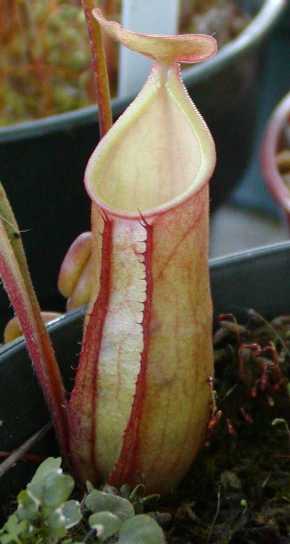
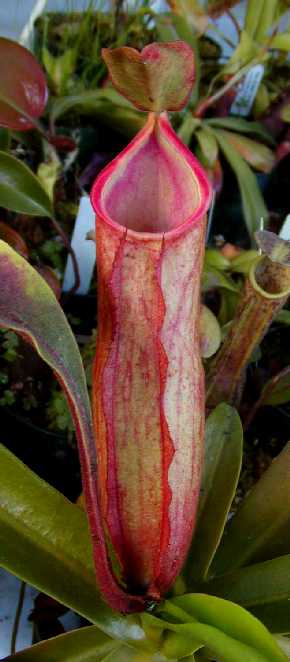
photo taken 11 / 04
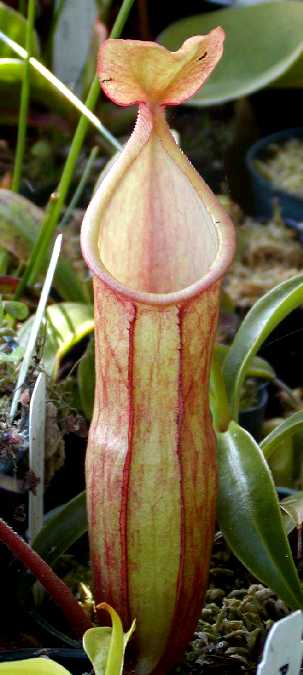
N. thorelii
purchase date: 5 / 01
arrived as a size 3
plant origin: CP Jungle, probably originated from
Exotica Plants
photo taken: 7 / 05

N. thorelii "d"
purchase date: 5 / 06
arrived as a rooted cutting
plant origin: Exotica Plants
photo taken: 11 / 06
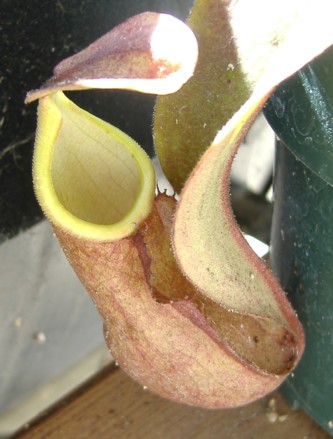
N. thorelii "Wistuba clone"
purchase date: 5 / 06
arrived as a small size 3
plant origin: Nepenthes Nursery
photo taken: 11 / 06
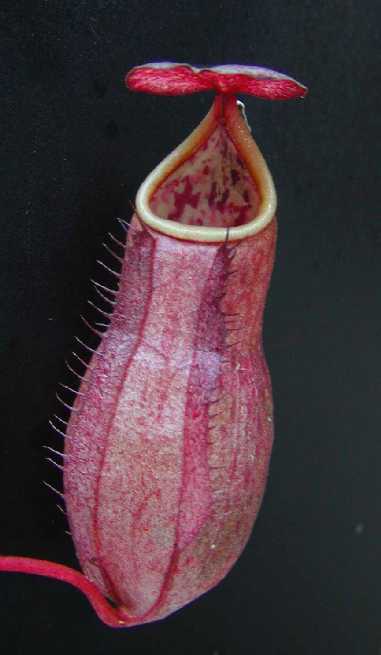
N. thorelii
"purple"
purchase date: 5 / 05
arrived as a good size 3
plant origin: Exotica Plants
photo taken: 5 / 05
Nepenthes thorelii is a plant that I'm not too familiar with. I originally
bought one plant from the CP Jungle and the grower told me his N. thoreliis
did okay when the temperature dropped in his greenhouse so I decided to
give it a try. When I received my plant it did go through an initial shock
phase with leaf curl and pitcher drop off. Usually this is due to transplant
shock because of root disturbance. But after a while it adapted and currently
is doing well outdoors yearround. This particular N. thorelii has somewhat
papery leaves and would prefer higher humidity than I'm giving it, but it has
adjusted to outdoor growing fine. I've also noticed that when it flowers, it
produces an exceedingly long flower spike with a small cluster of flowers on the
end. Other Nepenthes tend to spread out their flowers more evenly on the flower
stalk. This variety slows down considerably during winter.
Another variety of N. thorelii from Exotica Plants is their "d". I
got this one because it is supposed to have some purple in it. I originally had
it in my bedroom but since have moved it outdoors and it is doing much better.
I've found that even though Exotica's thoreliis are lowland to intermediate,
they can be grown and do well in my highland outdoor conditions. The leaves on
the "d" form aren't as papery as my other form. The photo of the
pitcher above may be an upper or a lower. I'm not sure since I haven't seen any
photos of this plant. In fact, I'm not 100% sure if N. thorelii produces more
than one kind of pitcher. Whatever the case, Exotica Plants uses N. thorelii in
a lot of their spectacular hybrids in this species adds to the vigor and color
of the crosses Exotica produces.
The Wistuba clone I'm also growing outdoors. The leaves are somewhat papery
but it seems to be doing fine under shade cloth. If memory serves, the Nepenthes
Nursery lists their N. thorelii as being a highlander so I'm growing it that
way. This clone has yet to go through a winter but I suspect it will slow down
for many months and then resume growing when the months heat up again.
My N. thorelii "purple" was purchased from Sunbelle Orchids but the
original seed grown plants came from Exotica Plants. I was told by the grower
that this thorelii is "the real thing." The pod parent (or mother
plant) for the N. thorelii purple came from Brisbane Botanical Gardens, and the
pollen parent is a wild collected plant. They told me each plant has individual
characteristics and describe them as sort of "raff-like." The leaves
of this variety are not papery but more waxy similar to other strap-like leafed
highlanders. So I immediately started growing them outdoors without problems.
The pitchers are a nice purple and with more time and sun exposure, may turn a
darker purple. There's a lot of debate as to what is the "real"
thorelii. As of late, there seems to be great confusion
over the true identity of N. thorelii in cultivation. I've been told
that my reddish plant resembles other "N. thoreliis" in cultivation. However, I've
also heard that the true N. thorelii might not be in cultivation. I have
no answer to this controversy. I have searched the net and found N. thorelii
listed as a lowlander and a highlander. Most of the literature and feedback
leans towards lowlander conditions for this species. I believe most other growers grow their N.
thoreli's
as lowlanders to intermediates. The grower of the "purple" variety
says that hers have taken temps into the 50's without any problems. So my guess
is this plant will do well all year, but will slow down a lot during winter. We'll
see about that.
RATING
lowlander 0m-900m
Cultivation: moderate outdoors, probably easy under
typical lowland conditions; slow to moderate grower outdoors
Market availability: size 2, size 3, to rooted
cuttings; somewhat uncommon
Species variability: some (if there is a real N.
thorelii in cultivation) A, B, C, D, purple, red, squat
$ / size: inexpensive to moderate; $20.00-$35.00
Cuttings: none available for trade
Sex: female plant for the "normal"
variety





